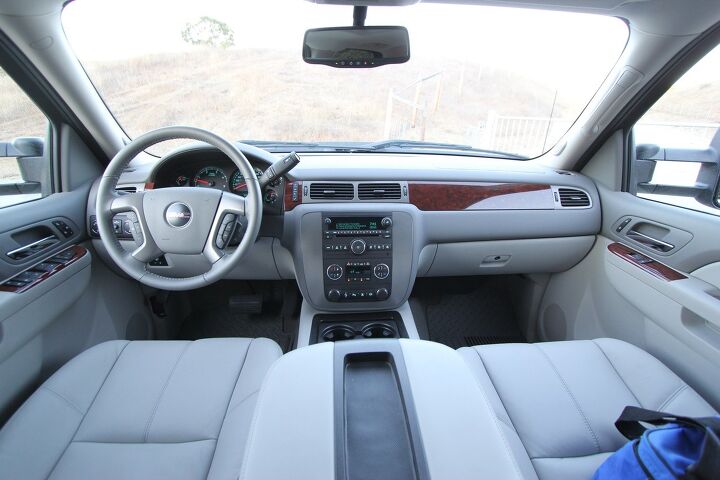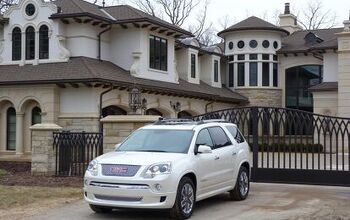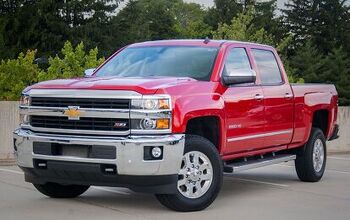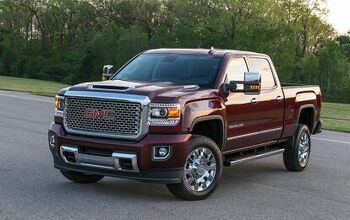Review: 2011 GMC 2500HD

Styling changes at GM seem to either come either in questionable radical leaps like the Pontiac Aztec, or creep glacially by, and GM’s 2500HD trucks definitely fit into the latter category. Despite being fully redesigned in 2007 as a 2008 model year truck and gaining a “full mid-cycle refresh” for the 2010 model year, the 2500HD is undeniably a GM truck. That means you get basic slab sides, a large square maw and the same sort of styling creases in the sheet metal that everything else from GM wears.
When GM’s PR people dropped the 2500HD off, the first thing I noticed from my window was the incredibly large, incredibly ugly plastic power dome on the hood. I understand the desire for something unique, but I have to agree with PickupTrucks.com when they say that it appears GM just got “louver envy” and tacked something on that looks more aftermarket than the aftermarket would ever think possible. Aside from the wart on its nose however the rest of the GMC HD is as plain Jane as a Buick, which is to say attractive in a farm-girl kind of way.
Inside the GMC 2500HD you’ll find two different interiors. If you opt for the basic work-truck you get the basic interior; style circa 1995. While the base interior is certainly functional for a work truck, it is at least a decade behind the competition. The acres of questionable black plastic circa the redesign in 2007 have not aged well. While I understand that interior quality is not really the most important item when buying a ¾ ton pickup truck, it would be nice if you didn’t have to spend your day in a plastic penalty box. If you step-up to the SLT trim (our tester was so equipped), GMC swaps the black plastic dash in the 2500HD with the dashboard from the GMT900 series SUVs (Suburban and Yukon). While I appreciate the intention of offering a more car-like dashboard in a heavy duty pickup, I question if a work truck is the right place for acres of awful fake wood? Aside from the never-seen-a-forest veneer, the plastics in our tester were already moderately scuffed after only 2,300 miles of press fleet duty. Make your own longevity conclusion.
On the road the GMC 2500HD yields road manners that are easily second only to the Dodge Ram 2500. For a truck capable of hauling a small house, the GMC drives like a smaller vehicle without any of the harsh “crashy” ride quality that you would assume a high-load capacity truck would bring to the table. Even when loaded up with 3,360lbs of concrete (my favorite load comparison), the road manners of the 2500HD were impeccable. The brakes easily scrubbed away speed, and the 765lb-ft of torque make themselves known when climbing any kind of hill.
Speaking of engines, GM’s V8 diesel is a willing companion for any kind of work. If it weren’t for Ford stealing GM’s thunder with their 800ft-lb torque monster, everyone would still sing GM’s praises. Truth be told the GMC 2500HD scoots to 60 faster with or without a load than the Ford truck. This difference is likely due to the gearing in the Ford and some differences in curb weight. Churning out 397HP and 765ft-lbs of torque, the GM 6.6L V8 sends power to the ground via a 6-speed Allison transmission and this is where the GM disappoints a bit.
The gearing of the Allison transmission’s first gear isn’t as low as Ford’s new 6-speed tranny. This makes the Ford “feel” faster when taking off from stop lights or dealing with stop-and-go traffic. When the accelerometer comes out however it was obvious that the GM truck is still the speed king eeking out a 0.2 second better 0-60 time (8.8 seconds vs 9.0 for the Ford). This area is so subjective that after a back-to-back drive I have to still call this a wash. The GMC is still objectively faster to 60, but the lower first gear of the Ford makes stop-and-go traffic while hauling 13,000lbs far less tiring than the GMC.
If there is one area where GM falls seriously behind even Chrysler, it’s in the electronic gadgets department. While the sounds produced by the top-of-the-line audio system sounded good, they didn’t have the premium feel of the Kicker system Dodge makes available in the RAM. Had it sounded as good I might have been tempted to overlook the lack of decent digital music player connectivity. Yes the GM stereo does let you control your iPod, but attempting to do so will fill you with frustration until you just unplug the damn thing and just browse it manually.
When out on the job payloads and towing capabilities are important but in typical use, the payloads and towing are essentially the same between the F250 and 2500HD depending more upon what tire and option packages the buyer chooses than what brand of truck. When configured more-or-less identically the payload capacity differs by a few hundred pounds, but since most of this is not verified to any specific metric independently, I have to call it a wash. While we’re on the topic of payloads, the days of needing a dually are over for most buyers. There was a time when you needed a 3500 series truck with four tires out back to haul crap but no more, today’s 2500s will carry more than a 3500 could handle a decade ago. Back in 2009 a SRW 3500HD could only haul 2,906lbs and tow 13,000lbs while the dually equipped 3500 DRW could haul 4,042 (about 40% more). In 2011 the GMC 2500HD can haul a whopping 4,192 in its bed when properly equipped. Yowza!
At the end of the week with the 2500HD I decided to drop by my local Ford store to compare the trucks side by side and as a result I must say the 2500HD comes in a close second to the F250, but still second and here’s why: the devil is in the details. Yes the GMC delivers better numbers in many areas, but the difference is small enough that the smaller touches in the F250 swing my personal vote. Ford may not have über-cool exhaust brake option as the Dodge of GMC truck, but Ford offers superior control over the transmission shifts which I found very helpful while hauling heavy loads. In addition the Ford SYNC system makes it easier to focus on your driving instead of your iPod. Adding to the “little touches” list are the 4.2” LCD info center in the Ford’s dash (Dodge has one as well) that is much better at giving the driver feedback than the small electro-fluorescent display GM uses. Ford manages to also put the Diesel Exhaust Fluid (DEF) filler in a more sensible location (behind the fuel door rather than under the hood) making filling far more convenient. Finally at nearly $57,000 as equipped the comparable F250 rings in a hair cheaper. While you can’t go wrong buying the GMC Sierra 2500HD for its better performance, if this is a truck you personally have to live with every day there is a better option.
GMC provided the vehicle, insurance and one tank of gas for this review.

More by Alex L. Dykes
Latest Car Reviews
Read moreLatest Product Reviews
Read moreRecent Comments
- W Conrad I'm not afraid of them, but they aren't needed for everyone or everywhere. Long haul and highway driving sure, but in the city, nope.
- Jalop1991 In a manner similar to PHEV being the correct answer, I declare RPVs to be the correct answer here.We're doing it with certain aircraft; why not with cars on the ground, using hardware and tools like Telsa's "FSD" or GM's "SuperCruise" as the base?Take the local Uber driver out of the car, and put him in a professional centralized environment from where he drives me around. The system and the individual car can have awareness as well as gates, but he's responsible for the driving.Put the tech into my car, and let me buy it as needed. I need someone else to drive me home; hit the button and voila, I've hired a driver for the moment. I don't want to drive 11 hours to my vacation spot; hire the remote pilot for that. When I get there, I have my car and he's still at his normal location, piloting cars for other people.The system would allow for driver rest period, like what's required for truckers, so I might end up with multiple people driving me to the coast. I don't care. And they don't have to be physically with me, therefore they can be way cheaper.Charge taxi-type per-mile rates. For long drives, offer per-trip rates. Offer subscriptions, including miles/hours. Whatever.(And for grins, dress the remote pilots all as Johnnie.)Start this out with big rigs. Take the trucker away from the long haul driving, and let him be there for emergencies and the short haul parts of the trip.And in a manner similar to PHEVs being discredited, I fully expect to be razzed for this brilliant idea (not unlike how Alan Kay wasn't recognized until many many years later for his Dynabook vision).
- B-BodyBuick84 Not afraid of AV's as I highly doubt they will ever be %100 viable for our roads. Stop-and-go downtown city or rush hour highway traffic? I can see that, but otherwise there's simply too many variables. Bad weather conditions, faded road lines or markings, reflective surfaces with glare, etc. There's also the issue of cultural norms. About a decade ago there was actually an online test called 'The Morality Machine' one could do online where you were in control of an AV and choose what action to take when a crash was inevitable. I think something like 2.5 million people across the world participated? For example, do you hit and most likely kill the elderly couple strolling across the crosswalk or crash the vehicle into a cement barrier and almost certainly cause the death of the vehicle occupants? What if it's a parent and child? In N. America 98% of people choose to hit the elderly couple and save themselves while in Asia, the exact opposite happened where 98% choose to hit the parent and child. Why? Cultural differences. Asia puts a lot of emphasis on respecting their elderly while N. America has a culture of 'save/ protect the children'. Are these AV's going to respect that culture? Is a VW Jetta or Buick Envision AV going to have different programming depending on whether it's sold in Canada or Taiwan? how's that going to effect legislation and legal battles when a crash inevitibly does happen? These are the true barriers to mass AV adoption, and in the 10 years since that test came out, there has been zero answers or progress on this matter. So no, I'm not afraid of AV's simply because with the exception of a few specific situations, most avenues are going to prove to be a dead-end for automakers.
- Mike Bradley Autonomous cars were developed in Silicon Valley. For new products there, the standard business plan is to put a barely-functioning product on the market right away and wait for the early-adopter customers to find the flaws. That's exactly what's happened. Detroit's plan is pretty much the opposite, but Detroit isn't developing this product. That's why dealers, for instance, haven't been trained in the cars.
- Dartman https://apnews.com/article/artificial-intelligence-fighter-jets-air-force-6a1100c96a73ca9b7f41cbd6a2753fdaAutonomous/Ai is here now. The question is implementation and acceptance.















































Comments
Join the conversation
I would use the word "plain Jane" to describe the Ram with every model looking as stark and plain as the stripper version aside from the wheels. You have to pony up for the top trim level to get two -tone paint. The Silverado at least has some exterior trim, chrome and style/character that the overly plain Ram lacks. The upper trim level interior looks fine in most any used example I have sat in, even with up to 80K miles so wear doesn't seem to be a big issue here and is about even with the other big 3 trucks. I do agree that the lower trim level Silverados need a refresh and upgrade however and the 4.8 and 5.3 are falling behind in power and torque compared to Fords new engine line and Dodges Hemi.
I don't care for the looks of the redesigned ram myself, but it still looks better than those god awful looking gm trucks, especially the chevy. I think they even have the tundra beat in the ugly department, I know big trucks are supposed to be a bit square looking, but the gm trucks look like they were cut out with an xacto knife. Yeah a buddy of mine has a newer silverado and the center gold piece in that ugly oversized bowtie on the tailgate fell out. GMC = gay man coming.